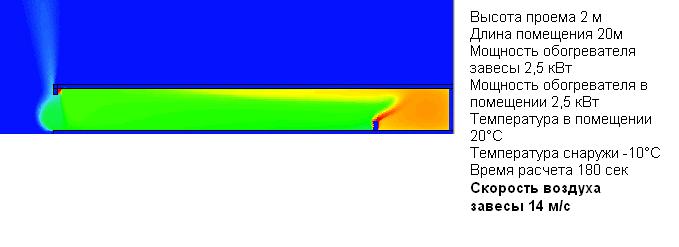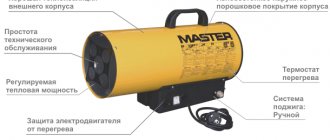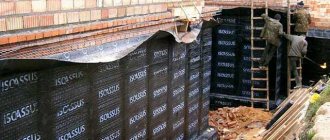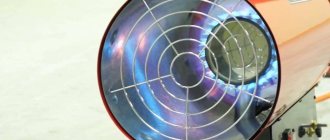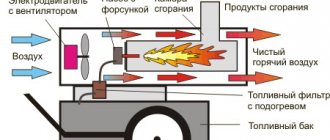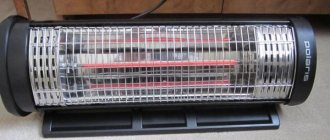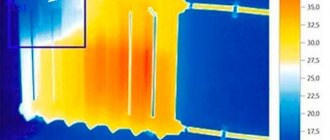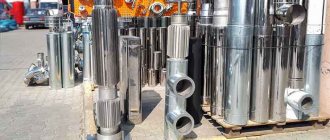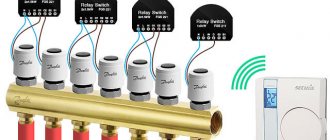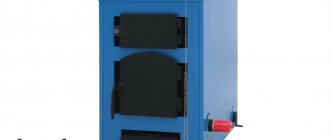It is unpleasant when cold air enters a warm house and cools it down. However, this problem can be easily solved. In order to maintain the optimal indoor temperature, thermal curtains have been developed. This equipment will help prevent warm air from escaping to the outside and keep the cold from getting inside. Such a system serves as a barrier separating the house and the outside space with the help of an air jet that is supplied automatically.
You can not be afraid of the cold if you install curtains.
Main characteristics
There are systems that operate on various heat sources. There are electrical and water curtains. The second type is more economical to use, since heating occurs at the expense of hot water.
Such equipment has many advantages, including:
- Reliable protection of the premises from heat loss.
- Creation of a special barrier that does not allow dust, various insects and exhaust gases to enter the house.
- Preventing cold air from entering the house.
- Temperature optimization.
- Additional heating.
- The ability to keep the door open in the house.
- Creates a cool and comfortable temperature in hot summer conditions.
- Profitability.
The principle of operation of the thermal curtain
This device is also called a heat separator for its work. The heat inside the building is stored by means of a vertical air flow. In this case, air acts as a heat insulator and performs this quite effectively, given its low ability to transfer heat.
The thermal insulation properties of air are widely used - most heaters are either foam materials, inside the bubbles of which there is air or an inert gas, or a fibrous material that holds air with a pile. Clothes that block the flow of air with the fibers of the fabric or wool in the fur work in a similar way.
In a thermal curtain, air prevents heat loss by protecting it from horizontal air currents. The room is separated from the outer space by a wall of heated air. The vertical movement of the air is provided by a powerful fan. The heat curtain is placed above the door, and the heated air from it enters the floor and further spreads inside the room.
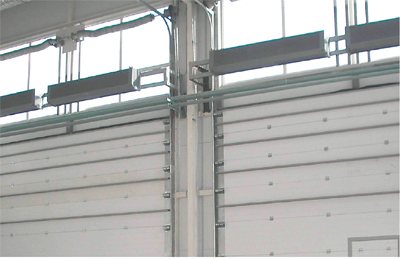
Due to the temperature difference, cold air cannot enter the room, which protects the internal atmosphere from such unfavorable influences:
- Insects;
- Dust and other air pollutants;
- Traffic fumes;
- Smoke;
- Unpleasant odors.
To effectively protect the room from external influences, it is necessary to heat the air. The effectiveness of this protection will be significantly reduced if the air in the heat curtain is at or colder than the room temperature. Also, additional circulation of cold air will only lead to discomfort. Therefore, the device producing the heat curtain is provided with a heating element.
Heat curtains are divided into electric and water curtains according to the method of air heating.
Despite the presence of heating elements, the heat curtain is not a full-fledged heating device. Its main task is thermal insulation. Therefore, the power of this device must correspond to the power of the heating devices - the excess power of the thermal curtain will only lead to unnecessary expenses, and will not improve the heating of the room.
Main element
The main component of the design is the central fan. This element must be located along the entire length of the system and be uniform in order to create an even flow. The motor is located on the side of the fan.
However, some manufacturers place the engine in the center and small turbines on the sides. The reason for this decision is the difficulty of creating a full-fledged element of the required length. Such a water air-heat curtain has a more affordable cost, however, its protective properties will not be enough. The air flow will feel a "dip" in the center. Moreover, the heating elements will be blown unevenly, which will significantly reduce the service life of the equipment.
Equipment management
The system must have at least two switches, one of which is responsible for the heating elements, and the other for the fan. In addition, the heating power regulator can be installed, which includes two or three switching levels. The fans can run at two speeds. The curtain has a thermostat that automatically turns off the heating elements when the programmed temperature is reached.
There are wired and built-in consoles to control the system. The variety depends on the specific model. The built-in type is used for small curtains installed for doors and windows. This is due to the fact that in this case the user will simply reach the buttons.
In some situations, it makes sense to install a limit switch that allows the system to start only when the door is open. It is especially useful in a hangar or warehouse.
Control and regulation of air curtains
Air curtain control is necessary to prevent overuse of energy by changing the characteristics of the air curtain according to each situation.
By using appropriate controls in conjunction with auxiliary devices, the customer can adjust the air flow, temperature, to optimize the operation of the heat curtain and avoid air penetration through the doorway.
Basic control Manual automatic control Smart control
Basic controllers allow manual adjustment of ventilation speed and heating stages.
Advanced controllers can include options such as:
- Automatic operation: changing ventilation and / or heating depending on the task
- Connection to external sensors and / or devices
- Turn on internal sensors (temperature, movement, etc.)
- Interface connection to automation systems, external on / off, thermostatic control
- Internal security programs (protecting components and avoiding damage)
- Door contact, valves, heating medium sensors, etc.
Door contact (magnetic, mechanical) Solenoid valve Frost sensor
External sensors and devices help monitor and modify the characteristics of the air curtain to protect the device and improve efficiency in every situation.
For example, if we install a door contact connected to an air curtain, when the door remains closed, the air curtain is turned off, or operates at a low ventilation speed and / or at a lower heating setting, which saves energy. When the door is opened, the air curtain increases the ventilation speed and / or heating stage to protect the doorway.
Another example is connecting an air curtain to a room thermostat. The device will then increase / decrease or stop heating when it reaches the desired temperature.
Techholod has a wide range of controllers from standard manual to advanced automatic functions and an interface for connecting air curtains to automation systems.
In addition, we offer a wide range of accessories: all kinds of supports, room thermostats, door contacts, solenoid valves, antifreeze sensors, etc.
Choice of design
There are many factors to consider when choosing the right system. Including:
- Performance. It directly affects the air flow rate as well as the installation height of the equipment. For example, for a door 2 meters high and 1 meter wide, a curtain with a "pumping" of 700-900 cubic meters / hour is suitable. The cost of such equipment will be quite high. For installation in small openings, systems with a lower performance are purchased. Since such structures are most often used in industrial premises, one should not save on this factor, otherwise the system will be ineffective.
- Power. As an example for the calculation, we can give a room of 10 meters squared with a ceiling height of 3 meters. In this case, the power should be - 1 kW. However, in such a situation, the building must be thermally insulated. For well heated areas, you do not need to choose a high power system. It is worth remembering that the air leaving the system will not be hot even at the highest power. Its temperature is always warm, since the heating elements blow at a high speed.
- Length. It can be from 60 cm to 2 meters. The most popular length is 80 cm-1 meter. Such systems are mounted above the door, therefore they are not suitable for industrial purposes. In order to select effective equipment, you need to choose structures with a length equal to the width of the opening or slightly more.
How to choose a thermal curtain - basic characteristics
Horizontal or vertical
The most popular arrangement of the thermal curtain is horizontal. Such a device is fixed above a door or window opening inside the room. But there are situations when it is impossible to establish a horizontal model:
- If there is no free space above the door.
- If the width of the opening is much greater than its height. A classic example is automatic sliding doors in a shopping center.
A horizontal curtain cannot be fixed vertically and vice versa. If positioned incorrectly, the fan bearings will quickly fail. In this case, the owner will not only spend money on repairs, but also lose the warranty on the device.
Length
The dimensions of the device are the most important parameter. If the dimensions are incorrect, the curtain will definitely not fulfill its function.
The length of the device should be slightly longer than the width of the opening. For example, for an 800 mm door, a curtain of 810 mm or more is suitable. The only exceptions are vertical models: most often they are selected strictly according to the height of the doors.
If the opening is too wide, several curtains can be installed in a row. They are fastened close to each other, creating a continuous air wall. The general rule remains the same: curtains should slightly overlap the width of the doorway.
Performance
Shows how much air the device pumps through itself over a given period of time. Let's look at the most common use cases:
- Windows in kiosks - a curtain for 300 - 350 m³ / h is sufficient.
- Doorway 200 × 80 cm - at least 800 m³ / h.
- Doorway 250 × 90 cm - from 1100 m³ / h.
If the heat curtain has heating, and the passage of the room is low, you can deviate from these figures to the smaller side. Heat losses will increase, but in general they will not be critical. With a comparatively low productivity of 400 - 500 m³ / h, some models provide quite a comfortable microclimate.
Remember that performance directly depends on the length of the curtain. If a 100 cm device pumps through itself 1,000 m³ / h, then its 200 cm counterpart should deliver twice as much - 2,000 m³ / h.
If the opening area is large, it is better to contact a professional consultant to select the curtain. The most productive devices are made to order.
Maximum installation height
For the curtain to work effectively, the air wall must extend to the floor. A properly selected device gives a flow velocity of 2.5 m / s at the lowest point. If this condition is not met, drafts will make their way into the room through the lower part of the doorway.
To simplify the selection, manufacturers indicate the maximum installation height. For inexpensive models, this figure rarely exceeds 2.2 m - for the front door, more is not needed. High performance devices for industrial facilities can be installed higher.
You should not blindly trust the figure in the catalog, since the final result depends on the measurement technique. In order not to be mistaken with the choice, we advise you to focus on two indicators at once: the maximum installation height and productivity.
Heated or not
The air curtain can take on an additional function - heating the room. In this case, a stream of hot, but not scalding air is supplied to the outlet. In warmer months, the heating element can be turned off.
Heated air curtains fit perfectly into small rooms without heating - kiosks and shopping pavilions, garages, outbuildings. Sometimes the device is bought in addition to the main heating system - it all depends on the needs.
If the appliance is only required to separate the air flow between the street and the room, the heating element will not add any advantages. But finding a compact, unheated model is difficult today, so you shouldn't give up on this feature.
For heated curtains, several additional characteristics are distinguished.
Power, kWt). The higher this indicator, the larger the room can heat the device. With a ceiling height of 3 m, the power is selected at the rate of 1 kW per 10 m².
Heating element type. Heat curtains are divided into water and electrical ones. In the first case, the device is connected to a hot water pipe. The air passes through the heater and heats up. Such a device is difficult to install, but operating costs will be minimal. Typically, water heating is used in large industrial premises.
In other cases, it is more reasonable to purchase a curtain with an electric heater. Utility costs will be slightly higher, but only an outlet is required for installation. There are two types of electric heaters in thermal curtains:
- Spiral. The only plus is the low price. Cons - fragility and the effect of dried air, familiar from old heaters.
- Tenovye. More perfect and durable option, but more expensive.
If the budget allows, choose a heating element heater. Employees and customers will be more comfortable.
Voltage. The most powerful models require a 380 V power supply.The curtains for small rooms operate from a regular 220 V.
Control and automation
Budget models are equipped only with buttons for turning on the fan and heating. More expensive devices are usually remote controlled.
The heated curtain is sometimes equipped with a thermostat. It turns the heating element on and off if the room temperature reaches the limit values.
For warehouses, it is convenient to use thermal curtains that turn on automatically. Such a device works only when the gate is open, without wasting energy idle. But when installed above a regular door, there is no point in such switching: the fans simply will not have time to spin up in a short time.
Heat curtain market
There are many types of equipment.
The following manufacturers are popular on the Russian market:
- Ballu (international company). They produce products with minimal energy consumption.Both horizontal and vertical models are presented.
- Frico (Sweden). The systems have a remarkable design, reliability and high build quality.
- Tropic Line (Russian company). The equipment is highly efficient and affordable. The main specialization is household thermal curtains, however, there are several types of industrial models.
- Teplomash (domestic manufacturer). Produces quality equipment at affordable prices.
How heat curtains work
Evgeny Filimonov
Ask a Question
A heat curtain is a heater that generates a stream of warm air. For this, a fan and a heating element are provided inside it.
Some association with a fan heater suggests itself, and this is true, since these devices are structurally similar. They differ only in purpose, which will be discussed further. Otherwise, they have an identical design and serve to generate warm air.
If a conventional fan heater simply expels the heated air masses into the room, heating it, then the heat curtain performs a slightly different function. Its task is to create a falling air flow that prevents the ingress of cold air from the outside. This is true in entrance areas, where people often slam doors and drive cold into warm rooms. The heat curtain, generating heat, mixes it with cold air masses and neutralizes their effect.
The principle of operation of the unit itself is as simple as three kopecks. A fan installed inside captures cold air and drives it through the heating element, after which it is sent down. Opening the doors, people drive cold air masses into the room, which subsequently enter the heat curtain and heat up. It should be noted that the air temperature under the device itself is quite high, it is not very comfortable to be in this zone.
A thermal curtain is a reliable and convenient device that provides high-quality protection against many adverse external factors.
Other features of air curtains:
- Provide protection against the penetration of insects - they are simply knocked down by tight air currents;
- These heat heaters can work as conventional fans;
- Some curtains are equipped with an air filtration function, making the atmosphere in the house healthier;
- The presence of thermoregulation - if you choose a heat curtain with a thermostat, it will regulate the air temperature in the heated zone and save energy.
Now you know how the heat curtain works and what it can do.
Features of the thermal curtain
The heat curtain is a long fan that creates a flat and powerful flow of warm air. Its main function is to create an invisible barrier to the penetration of cold air masses into the room. A thermal air curtain is like a closed door in those buildings where there is always a large flow of people and the door is constantly opening and closing.
The thermal curtain is especially important for restaurants, shops, checkpoints, halls of business centers, subways. You can also install a thermal curtain for a house, for a summer residence, for a garage.
As for the place of installation - above the door or above the window. The curtain does not allow heat to disappear from the room when the front door is constantly open for a long period of time.
Purpose of thermal curtains
These units are used mainly in non-residential premises, but in houses they are much less common. The thing is that, in the overwhelming majority, these are rather powerful units with high performance. And in houses and apartments, such performance is simply not needed. For example, a heat curtain with a power of 1 kW can drive through itself up to 300-400 cubic meters / m of air per hour - this is irrelevant in residential premises.
Thermal curtains have found their application in commercial buildings - these can be shops, warehouses, production halls. In short, they are necessary where there is a large number of people passing through, often slamming doors. A typical example of this is any store - thousands of customers visit it every day, chilling the air in the trading floor. The use of a thermal curtain will save the accumulated heat.
If necessary, you can find the application of the thermal curtain in a residential building. If you actively use your personal courtyard in winter, then it will help keep warm in the hallway or at the back door. And by hanging it on the street, near a place to rest, you can create excellent conditions for outdoor gatherings - in this case, you need an infrared heat curtain, silent and efficient.
By the way, a thermal curtain with an infrared principle of operation is also useful in living quarters - here it will play the role of a heating device. You just need to choose the right power. Such a heater is also useful in household premises - these are sheds, garages, agricultural buildings and much more.
Thermal curtain device
What are thermal curtains made of and what is the difference between an air curtain and a thermal one? In fact, these are synonyms, but heat curtains are a type of air curtain. Why? Let's figure it out. The main components of any curtain include:
- Fan - tangential or axial. In curtains for small openings, tangential impellers are traditionally used more often, since they are more compact and create a continuous flow equal to the length of the impeller. In industrial curtains, powerful axial fans can also be used to protect openings with a height of more than 10 meters.
- Motors - differ in shaft power and energy class. The more powerful they are, the more air the curtain will pump and the higher and wider openings it will be able to protect.
- The body is usually made of metal or plastic.
- Curtain controls - buttons and rotors on the body or a separate remote control, which can be either wired or wireless.
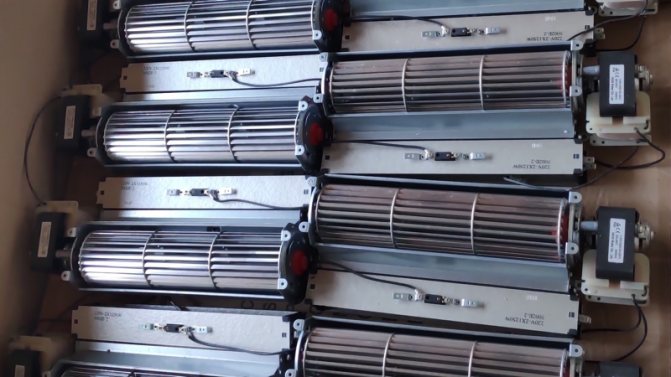

Air curtain motor
The heat curtain becomes when one more is added to the above components:
- Heating element - electric or water heat exchanger. Electric heating elements are used in different ways, most often they are classic heating elements (tubular heating elements) or stich-elements (needle heating elements).
Air curtains are designed to cut off cold air from outside and prevent it from entering the room. The main cutoff function is performed by the motor and fan. But in the case of a heating element, the air is also heated, due to which the device becomes more efficient.
Also, having the same components, the design of the heat curtain can be slightly different - depending on the location of the heating elements (at the air inlet to the curtain or at the outlet), the unit will either cut off the air better or heat it more.
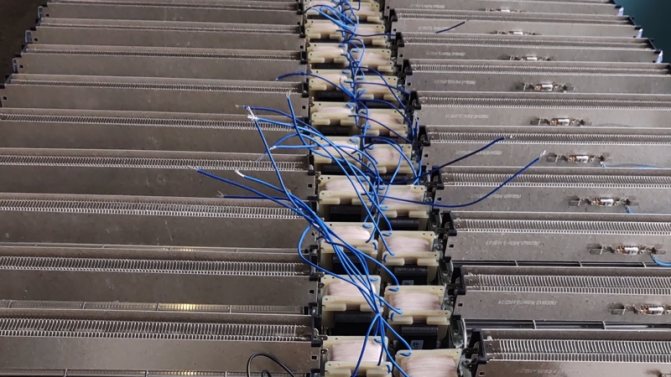

Heating elements of thermal curtains
Varieties of thermal curtains
When choosing a model, it is worth considering the dimensions of your doorway. The width of the blown out heat flux of the curtain should be wider than this indicator.
Next, we will tell you what kind of thermal curtains are. The most popular devices are horizontal. They are mounted above doorways and entrances and blow the air from top to bottom. We see them in stores and shopping centers, where there is a lot of traffic. The units differ in their size and performance, just like any other equipment.
Vertical thermal curtains are installed not on top of the doorway, but on its sides. There are two air currents - one on the right and one on the left.In terms of their effectiveness, they differ little from their horizontal counterparts, but they are more convenient for installation in rooms with low ceilings and high doors (when there is simply not enough free space above the doorways).
Evgeny Filimonov
Ask a Question
Built-in thermal curtains are less common, as they are characterized by a high price. They are built into ceilings and are distinguished by their invisibility. This is true in rooms with designer renovation, but in most cases, their concealment is not required. Therefore, they are quite rare on sale.
We can also distinguish several other types of heat curtains. But they are unlikely to be suitable for heating homes. Here is a list of them:
- Infrarede - most often they are used in shopping centers and at enterprises where it is necessary to prevent the cold from entering the premises without creating unnecessary noise;
- Aquatic - they are somewhat reminiscent of floor convectors with forced convection. They are distinguished by their increased power and high performance;
- Gas - these air curtains run on natural or liquefied gas, but they cannot be called safe (like any gas equipment).
Of all this, only infrared devices can be used at home.
Water curtains are most often powered by heating systems - inside them there are radiators blown by fans through which the coolant flows.
Advantages and disadvantages of thermal curtains
We will not take into account powerful industrial air curtains, but will pay attention to small-sized and low-power units powered by electricity.
Let's take a look at their main pros and cons.
Let's start with the positives:
If the width of the passage exceeds the width of the air flow of the heat curtain, then it makes sense to install two units side by side at once. Any gap in the coverage area will greatly reduce the overall efficiency of the system.
- Compactness - for all its performance, air curtains are small in size;
- High performance - thermal curtains can pass a huge amount of air through them;
- Large selection in terms of power - from 1-2 kW and above;
- Excellent customer reviews - everyone who has ever come across thermal curtains knows about their high efficiency;
- Reliable protection against the penetration of dust, smoke, exhaust gases and insects;
- The ability to work in the summer as fans with a very important function - in the summer they will prevent the penetration of heat into the premises.
There are also some disadvantages:
- High energy consumption is typical for all heating electrical appliances;
- Noise - efficient fans installed inside these devices make a noticeable noise, which makes it difficult to use them in residential buildings;
- Heating elements in these units burn oxygen - therefore, the premises must be ventilated.
Despite the tangible disadvantages, it is difficult to do without them.
Calculation of the thermal curtain
Let's talk about calculating a thermal curtain for a home. The main parameter is the height of its suspension - the required initial speed depends on it. The thing is that on the opposite side (near the floor, when installing equipment above the doors), the air flow rate should be 2-3 m / s. If this indicator is less, then the outside air will be able to penetrate into the room - the heat curtain will only waste energy. If the performance is too high, then the heat will fly out.
An incorrectly selected model, at best, may simply not give a positive result. And at worst, it can also aggravate the situation.
The initial speed directly depends on the working diameter of the fan. For example, with a diameter of 180 mm, the initial speed will be 15 m / s. With regard to power, it all depends on the area of the room and performance.
The optimal performance indicator for doorways 800-1000 mm wide and 2000-2200 mm high is from 700 to 900 cubic meters. m / hour, power - 6 kW (a little more is possible). For a more accurate calculation of all indicators, we recommend using online calculators.
The right choice of air curtain
The choice of a thermal curtain or several thermal curtains for a specific opening is a rather responsible decision, since this choice will affect the comfort conditions near the opening and energy consumption, which is directly related to the compensation of heat loss through the opening area. To reliably cover the opening with air curtains, their characteristics must correspond to the conditions at this opening.
How to choose curtains for the opening? This can be done in various ways, such as contacting an air curtain manufacturer who has extensive practical experience in covering openings. You can also contact a specialized design organization. And finally, you can choose air curtains for the same openings by analogy with the already functioning installations.
For the air curtain, the principle “more is always better” is not fulfilled. For clarity, we will give an example of installing a certain Tropic-Line air curtain on an opening. The characteristics for all three figures completely coincide only with the exception of the initial air flow velocity of the curtain.
In the figures above, the conditions are exactly the same except for the air flow rates. The initial air flow velocities of the curtains are chosen so that in the first case it is demonstrated what the consequences are of insufficient air flow rate (the room temperature is close to the outside temperature), for the second - the optimal speed, and for the third - excessive. Comparison of the temperature conditions of the second and third figures is of particular interest. Although the performance (or air flow rate) of the air curtain increases, the room temperature drops. Thus, despite the fact that the air curtain shown in the third figure is more expensive than the air curtain in the second (its characteristics are much better), it leads to large heat losses at the opening and, accordingly, to worse conditions. The optimal air flow rate is shown in the second figure. Recall that this speed is optimal only for the conditions shown in the figure. If the outside temperature rises, even this speed will become excessive in relation to the optimal one. If the outside temperature decreases, then the speed of 6.75 m / s will no longer be sufficient.
This feature of the use of air curtains explains the need to include in the design of the air curtain the possible setting of different air flow rates and, therefore, different air flow rates.
Almost all series of Tropik-Line air curtains, with the exception of the smallest ones (A and K), have several settings of air flow rates, which allows you to adjust the characteristics of the air curtains for specific conditions.
Air curtains A wide range of air curtains for commercial, industrial and residential use.
Go to catalog
Temperature control
Any heating equipment needs a temperature controller. Otherwise, it will consume too much electricity, obviously overheating the air in heated rooms. The simplest air curtains have built-in thermostats - they analyze the temperature of the sucked in air, turning the heating elements on and off.
A remote thermostat for a thermal curtain is an element of much more powerful devices. It is an electronic or mechanical thermostat that controls the operating modes of the equipment.When the air overheats, it turns off the heating, only the fan works. If the air cools down too much, the thermostat turns on the heating element. There may also be controls for other functions.
Simple household thermal curtains use simple infrared remote controls.
Choosing a thermal curtain - the main criteria
Next, we will consider how to select a thermal curtain. As we said, the first two metrics are suspension height and performance. You also need to pay attention to the maximum dimensions of the doorways. If the heater is to be used as auxiliary heating for residential premises, its power should be 20-40 W per 1 sq. m. Here we can use any suitable model.
Having such a thermostat, you can remotely and with an accuracy of a degree adjust the operation of the device.
We also pay attention to the way functions, temperature and performance are controlled. More convenient are units with remote controls - wired or wireless. Thanks to this, you will be able to adjust the parameters of the equipment from a more convenient place. External thermostats are sold separately in most cases.
The type of installation is determined individually - in households where low-power air curtains are traditionally used, horizontal models are most often installed. As for the vertical units, they are focused on use in commercial and industrial premises.
As for brands, here we recommend taking a closer look at foreign-made thermal curtains for a home. There are also quite good domestic units on sale - as an example, we will give heaters of the Tropic and Teplomash brands.
We also pay attention to the following details:
- The ability to work as a fan - useful in the summer;
- The presence of a thermostat - will maintain the set temperature and save energy;
- Overheating protection - will provide equipment protection;
- Noise level is an important parameter for home use, because the house should be quiet;
- Mounting type - wall or ceiling.
The right choice will ensure reliable, stable and trouble-free operation of the equipment.
You can familiarize yourself with the descriptions of certain models in our review - we will consider the most popular units. You can also take a look at the product aggregator
How to choose the right thermal curtain
How to start choosing a thermal curtain?
Inspect the room and decide where you plan to install the heat curtain. Think about what is more important for you: to protect the room from cold masses from the outside or to heat the air inside. Remember, the better the curtain works as a barrier, the worse it is as a heater.
If you have a vestibule in front of the front door, it makes sense to select a heat curtain with a small air blow. A small air flow cools the heating element less. The heated air will mix with the outside air, heating it to the required temperature. To solve most of the problems, a heat curtain of 3-5 kW with air blowing of 300-500 cubic meters is sufficient. If funds and the availability of electric power allow, we put the curtain at 6 kW. 380V with blowing 800-1000 cubic meters
If you plan to use a thermal curtain as a barrier, the task becomes more difficult.
First, we decide on the type of air curtains: water or electric, and the availability of the required power to connect them. Electric thermal curtains are easier to connect, and water curtains will significantly save on operation in the future. Then we measure the height and width of the opening, which must be protected from the cold. We choose the type of installation horizontally or vertically. Horizontal installation is preferable, but on openings more than 3 meters in height, the effectiveness of such protection decreases.Vertical installation usually implies the installation of air curtains on both sides opposite each other. For openings from 3 meters wide, this is the best solution!
Suppose we chose a horizontal installation, our doorway is 2.2 m and its height is 2.1 m.
We select a series of curtains starting from the effective jet length. Remember that this parameter is very different at different operating points: the air velocity at the exit from the nozzle is, for example, 9m / s, and at the lowest point, only 2.5 m / s. Therefore, for effective work, it is better to choose with a margin, for example, with an installation height of up to 3.5 m. Next, we select the curtain according to the width of the opening. For 2.2 meters, it will be enough to use a curtain with a length of 2.0 m. Standard sizes of the thermal curtain on the entrance door for large openings, multiples of 0.5 meters: 1.0; 1.5; 2.0; If it is necessary to cover a large width of the doorway, we select curtains from the same series, but of different lengths, we install them in series close to each other. The length of the curtain may not coincide with the width of the opening by 10-20%. The air does not go along the line! It goes in a wedge with an extension to the bottom.
When installing vertically, we place the curtains closer to the bottom point, since cold air tries to penetrate into the room from below, and warm air comes out at the top.
The most crucial moment is the choice of the heat output of the air curtain. Be sure to consider the current room temperature. Remember, the main purpose of the air curtain is to cut off cold air, not to heat the room! The second function works only when the heat output is selected with excess. The heat curtain does not have to be blown with hot air. The passport indicates the delta to which the curtain is capable of heating the air passing through it. As a rule, this figure is 13-18 degrees. For curtains with a high heat output, it reaches 27 degrees.
What does it mean? If the temperature in the room is +5 degrees, then the exit from the nozzle will be + 20. Have you ever tried to warm yourself with a desktop fan? The result is not a comforting equation: More blowing is a better barrier, but a worse heater. When choosing a heat curtain, determine what you want, protect the room from the cold or keep warm. There are curtains that solve both the first problem and the second. But you must remember, the laws of physics cannot be fooled: we increase the power of the curtain and pay a lot for the time when it works.
For a catalog of various electric air curtains, see here.
If you have any questions, call our specialists by phone. Our managers will give you expert advice, help you choose the right thermal curtain for your task.
Remember, the right curtain will save you money and get the results you expect.
list of articles
Most popular models
If you are planning to buy a thermal curtain, the information from our review will come in handy. Let's take a look at the top-rated devices with you and describe their technical characteristics.
The power of the heat curtain is 3 kW, so this unit can well be used to heat apartments and private houses. Also, the heater is useful in technical and utility rooms - these are workshops, garages, outbuildings and much more. The price of the heater varies from 3.5 to 5 thousand rubles.
Evgeny Filimonov
Ask a Question
The air curtain has a capacity of 350 cubic meters. m / h, installation height - 2.5 m. The power stepwise adjustment is provided - 1500 or 3000 W at the choice of the consumer.
The main advantage of this heater is its attractive design, which makes it suitable for use in residential buildings.
When choosing a low-power thermal curtain, be sure to pay attention to this model. It is intended for use in private houses, outbuildings and outbuildings, in garages and small shops. Its power is 2 kW, productivity is 300 cubic meters. m / hour.The device is designed for horizontal wall installation at a height of 2.5 m. The control here is built-in, mechanical. Operation as a simple fan is possible. The noise level is only 45 dB - this is a fairly low-noise thermal curtain.
One of the simplest heat curtains. The model is far from being intended for domestic use, since it is distinguished by high power and productivity - 4.5 or 9 kW, 840 cubic meters. m / hour. Possibility of operation in simple fan mode is provided. The fact that this device is not for home is also evidenced by its appearance - somewhat "clumsy" and angular. The maximum installation height for this model is 2.2 m. There are only two controls on board - a general switch and a power selection switch.
Before us is another rating heat curtain with a capacity of 9 kW. The capacity of the unit is 900 cubic meters per hour; it is designed for installation in shops, supermarkets, production and storage facilities. There is a power control system on board, it is possible to work in ventilation mode. Despite the impressive power, the unit is compact and lightweight.
Working principle and installation
The principle of operation is quite simple: a powerful fan creates a high-speed air flow, which forms an "invisible barrier", thanks to such a system, warm air cannot leave the room, but cold air can penetrate into it. The heat source of the water curtain is hot water. It turns out that for the operation of a water-type device, central heating is needed.
It is, of course, difficult to install such equipment, but this cannot be compared with the fact that during operation the overhead costs are low, and the power is very high. The area of application of water curtains mostly extends to industrial buildings that have large openings. The device is indispensable in restaurants, shops and warehouses, that is, those in those places where the doors are opened very often due to the large flow of people.
Installation is usually done above the door. Installation above the opening means that the curtain is horizontal and to the side of the opening it is vertical. It should be remembered that the vertical curtain must be at least ¾ of the height of the opening to be protected. This is the only difference between this type of device and the horizontal one.
Main element
The main design element is a radial fan, which is necessary to create the required air flow. Such a turbine should be uniform and located along the entire length of the device. It helps to create an even flow. The engine is mounted on the side of it.
However, manufacturers often choose to center the engine with small turbines on either side. The reason for this arrangement of elements is the complexity of manufacturing a turbine with a length exceeding 800 mm. How effective is this installation method? Of course, such a simplified curtain will cost less, but there will be a "dip" in the central part of the air flow, which significantly reduces the protective properties. In addition, the heating elements will be blown unevenly, and this leads to their earlier breakdown.
How is the water curtain controlled?
The water curtain is accompanied by at least two switches, one of which must turn on the fan, and the other must turn on the heating elements. Heating power regulators can also be installed, which have two or three stages. Fans can be two-speed. The air curtain can have a thermostat that turns off the device or heating elements when the set temperature is reached.
There is a built-in and wired control panel, it all depends on the chosen model. However, the built-in type is used on curtains that are small in size, which are installed for windows and doors.This is because the distance depends on the ability to reach the buttons. Accordingly, for water curtains, it is more rational to use remote controls that can be installed in the right place.
Sometimes the use of a limit switch takes place, which is convenient in that it turns on the device only when the gate is open. It turns out that the switch starts to work when the doors or gates are opened. Its use is very convenient in warehouses and hangars.
Curtain control method
Any heat curtain has at least two switches - one switches on the fan, the second switches on the heating elements. In addition to this, some air curtains have two- or three-stage heating power controllers and two-speed fans. The control panel can be either built-in or remote (wired). Built-in remotes are used only on small curtains for standard door and window openings, otherwise the buttons will be difficult to reach. The remote controls are used with semi-industrial and industrial curtains - such a remote control can be installed in any convenient place.
In addition to the remote control, you can install a thermostat that will turn off the heating elements (or the entire curtain) when the preset room temperature is reached.
Curtain selection
The choice of an air curtain is influenced by the following factors:
- Device length.
- Power.
- Performance.
- Type of instalation.
- Control method.
We have already discussed the last two factors, now we will talk about the other three.
- Performance. It is on it that the air flow rate and the installation height depend. For example, let's take a doorway that is about one meter wide and about two meters high. In this case, the "pumping" of the curtain should be from 700 to 900 cubic meters per hour. With such a performance, the air flow rate will be about 8 meters per second at the outlet of the device, and about 2 meters per second at floor level. Of course, the price of such devices is not small, therefore, devices with lower performance are used to protect small openings. Since water curtains are used more for industrial buildings, it is impossible to save on this factor, otherwise the efficiency will be minimal.
- Power is also an important factor when you consider that the equipment can heat the air in the room, although this factor is not necessary at all. For example, let's take a 10 square meter building that is not heated and has a ceiling height of about three meters. The power required under such conditions is 1 kW. However, in this case, the building must be capital, that is, the ceiling and walls must have good thermal insulation. You should not choose a device with a high power for well-heated places, or even a device without a heating function. It is worth mentioning the peculiarity of the heating function: at the outlet of the curtain, the air will never be hot, even if the power is maximum, it will only be warm. There is an explanation for this: the heating elements have a high blowing speed.
- Length. It can be from 600 to 2000 millimeters. Lengths from 800 to 1000 millimeters are very popular, such devices are installed above a standard opening, therefore they are not suitable for industrial facilities, where water curtains are often used. How to correctly calculate the length in this case? It should be the same as the width of the opening or slightly more. This is important in order for the air flow to completely block the opening and prevent cold air from entering the room. All this information will help you choose the right water curtain, as it plays an important role in creating a comfortable environment. The installation of such equipment will indicate that caring for people is an integral part of any organization.
How to choose the right air / heat curtain
When choosing an air curtain, consider the following factors:
- Installation height is measured from jet outlet to floor
- Door width
- The location of the building to determine the level of protection required from weather conditions (temperature, humidity and wind)
- Arrangement of multiple doors, in the same area or opposite.
- Number of storeys of a building connected by escalators / stairs
- Differential pressure inside and outside the building
- Door characteristics: if it is always open, it opens automatically, opens manually, revolving door, etc.
- Characteristics of the ventilation and air conditioning unit
- The presence of a heat source for heating the curtain, electricity / hot water
- Business type, style and decoration of premises
- Curtain type, free hanging or recessed, horizontal or vertical. Heated or unheated, etc.
As it turned out, the choice of an air curtain depends on many factors. Below we show 4 different options from the easiest to the most difficult.
Easy situation Standard situation
Medium situation Difficult situation
Tekhholod's experienced consultants are at your disposal to help you select the right air curtain for all applications.
Contact the consultants of the Techholod company, we will select the right air curtain and reduce your costs! tel +7 or send a request by mail
